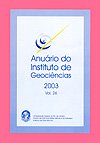Hydrogeological study of mangrove areas around Guanabara Bay, Rio de Janeiro, Brazil
DOI:
https://doi.org/10.11137/2003_0_92-100Abstract
The study area covers part of the mangrove belt located around Guanabara Bay, Rio de Janeiro, Brazil. Representing a continental-marine transition, the mangrove ecosystem is very susceptible to environmental variations and impacts. The vegetation cover plays an important role in prevention of erosion and contamination processes in those areas. An ongoing extensive research effort in the Petrochemical Complex of Duque de Caxias, Rio de Janeiro State, Brazil, focuses on the man-induced changes in the physical environment (soils, groundwater flow system, type and volumes of contaminants, geochemical aspects) and the consequences on the neighboring mangrove ecosystem. This article describes the importance of hydrogeological studies in mangrove areas as part of an appropriate environmental assessment, taking as an example an industrial dumping area located in that Petrochemical Complex. Field work included extensive drilling and sampling to obtain basic geological and hydrogeological parameters and data in the pilot area, such as hydraulic conductivity and piezometric heads; emphasizing the tracking of possible contamination by industrial effluents and the marine influence; validation of the conceptual model with mathematical models (numerical and analytical models) was carried out. Results show the great importance of well conducted and detailed hydrogeological studies to properly address environmental problems caused by industrial plants in mangrove areas.Downloads
Download data is not yet available.
Downloads
Published
2003-01-01
How to Cite
Silva Júnior, G. C. da, Braga, C. E. and Lage, I. de C. (2003) “Hydrogeological study of mangrove areas around Guanabara Bay, Rio de Janeiro, Brazil”, Anuário do Instituto de Geociências. Rio de Janeiro, BR, 26, pp. 92–100. doi: 10.11137/2003_0_92-100.
Issue
Section
Article
License
This journal is licensed under a Creative Commons — Attribution 4.0 International — CC BY 4.0, which permits use, distribution and reproduction in any medium, provided the original work is properly cited.















